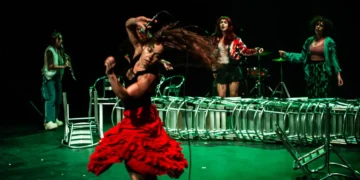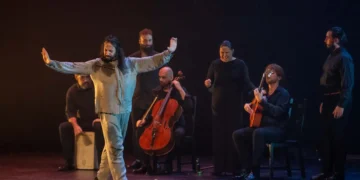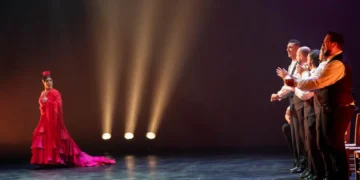|
FESTIVAL SUMA FLAMENCA 2011 ROCÍO MOLINA |
|
Dance, original idea, choreography, musical script: Rocío Molina; Guitar and music: Eduardo Trassierra; Cante and mandoline: Jose Ángel Carmona “Carmona”; Palmas and compás: José Manuel Ramos “El Oruco”; Drama coach: Roberto Fratini. “AUTORA” Text: Manuel Moraga It’s been some time now since Rocío Molina began the transformation from dancer to author, and stopped being a body mover at the service of a work. For a time, in the world of dance, people spoke of the perfection of her interpretation. For a long time Rocío Molina has been an artiste of dance, in the broadest sense of the term. “Vinática” is strongly in this line. Ever since I’ve known Rocío Molina biographically, the author, the person who creates the work, I have the feeling of being faced with a gamut of possibilities, and my question before the curtain goes up is, what facet of those possibilities will she show us today? And she nearly always positions herself on the newest facet, the one she has just added, the most extreme, the most daring. The question therefore is, how far can she go? Or, stated another way, what does she allow herself? Because the only limits are those within herself. “Vinática” delves into the biographical Rocío Molina via, I suspect, her own autobiography. Having said that, and entering into a purely literal analysis of the performance, I must admit that the show suffers from an excruciatingly slow pace to the point of exasperation. It just never quite gets off the ground. Or, perhaps it would be more precise to say the work gets going, yes, but at an even slower pace than that of the comfortably seated spectator. A languishing development, thick and dense, ends up making you uncomfortable and prone to disconnect from the goings-on. In my opinion, only when well into the first third of the show and the pace begins to pick up, are we returned to a less heavy-going narration where we can reconcile what’s happening on stage. We find therefore two well-differentiated emotional parts: the second being that which resolves best and where we can really enjoy the body language of our star. Rocío Molina’s creativity shows up little by little from the beginning, although it’s more apparent in the second half of the show. There are very interesting moments such as the bulería percussion dialogue that involves a suitcase, the siguiriya, the echoes of her own dancing, the infinite details that reside in the movements of her body, as well as the final number that has Rocío Molina at the edge of an abyss, and I must say, I think it’s the place Rocío Molina was most seeking. In this way she continues to push the possibilities. This is how, within her creative tension, we continually come upon more and more “Rocíos Molinas” who are constantly expanding the possibilities, showing us new dimensions and, along the way, multiplying the effect of moving the air around. Needless to say, the transmission of sensations and concepts difficult to define is complex. And this is why “Vinática” travels through symbolism and metaphor: at the same, that is the challenge and the risk. To sum up, I would add that the stage on occasion seemed too large for the needs of this show. I had the feeling of the dance being too disperse precisely because of that excess of surface to cover. We cannot overlook the excellent work of Eduardo Trasierra with the solid backup of José Ángel Carmona and José Manuel Ramos “El Oruco”. Without a doubt, Rocío Molina belongs to that order of artists who are not spectators of themselves, no matter how autobiographical their shows are: one thing has nothing to do with the other. But, and tying in with the opening idea, I believe that the artist who creates a work, that is, making a biography, must step back, sooner or later, from his or her own story. Rocío Molina will continue to be Rocío Molina, even doing a version of Snow White: just add another facet to the many possibilites that reside within her. Because, as Ana Olabarría says in the dossier of the show, the term “bailaora” no longer defines Rocío Molina. Technically, she’s a “danzaora”. I prefer to call her an author. |
Descubre más desde Revista DeFlamenco.com
Suscríbete y recibe las últimas entradas en tu correo electrónico.





























